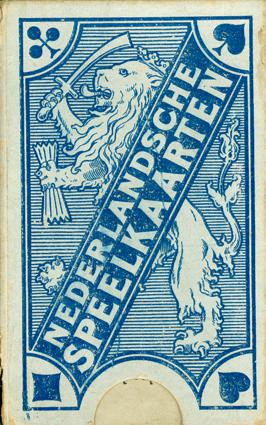ANOTHER MYSTERY SOLVED !
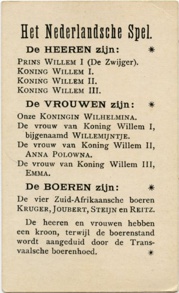 |
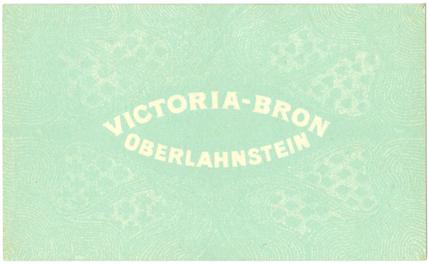
This is the deck that was known
among collectors here as the
"Victoria-bron" deck for a long time. When we found the deck in 2005 it came without a box, but with a title card, which finally confirmed
the correct name of the deck: "Het Nederlandsche Spel". |
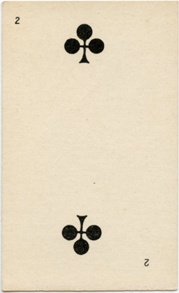 |
|
But that
still didn't resolve the question of who and where it was printed or published. It
wouldn't be the first German deck that was specially made for the Dutch
market and had a Dutch title and text card. Of course the size of the cards (
64 x 106) rather suggested a German origin too. So we did some research in
the here available books on playing cards. The deck is mentioned in Han
Janssen's "De Geschiedenis van de Speelkaart" on page 231 and described as
"Germany, ca. 1902". We also found it in the Cary Collection,
where it is numbered GER 434 and described as "Victoria Bron, Ems, c.
1900". |
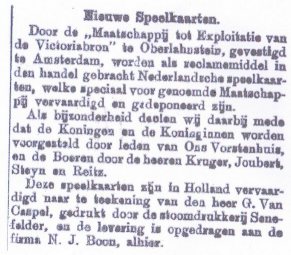 |
As both
these references pointed towards a German origin, we filed the deck here
under Germany too and put the courts and aces in our "Duitsland"
showcase holder. But in December 2008 we had
to transfer the deck and give it its final place in
"Nederland" (the Netherlands).
For this we have to thank LEX
RIJNEN, a collector and expert on Dutch playing cards. Through a fellow
collector we received the following newspaper article, that Lex had found and that discloses the origin of the deck in full. The article
comes from the "Nieuwe Koerier" of July 28th 1900.
The
translation reads: NEW PLAYING CARDS. By the "Company for
Exploitation of the Victoria Well" in Oberlahnstein, located in
Amsterdam, Dutch playing cards, which were specially made and deposited
for the afore mentioned company, are brought to the market as an
advertising means. As a specialty we declare here with that the Kings
and Queens are represented by members of our Royal House and the Jacks
by the gentlemen Kruger, Joubert, Steyn and Reitz. These playing cards
were manufactured in Holland, after the design of mr. G. van Caspel,
printed by the Steam Printers Senefelder and the delivery has been
commissioned to the firm N.J. Boon, local.
|

|
|
From an
almost identical article from the "Leeuwarder Courant" of
August 24, that Lex Rijnen has found, we now also know that N.J. Boon was located in
Amsterdam and that the price of the deck was f. 0,40 (f = Dutch guilder). |
Now that we know all the details about the origin of the
deck, we'll add some information about the cards too. On the courts
only the Kings and Queens have a crown as indicator, the Jacks are represented
by a typical "boer" hat. All the other cards, except for the Aces, have
small numbers as indices. The deck consists of 52 cards and a title card.
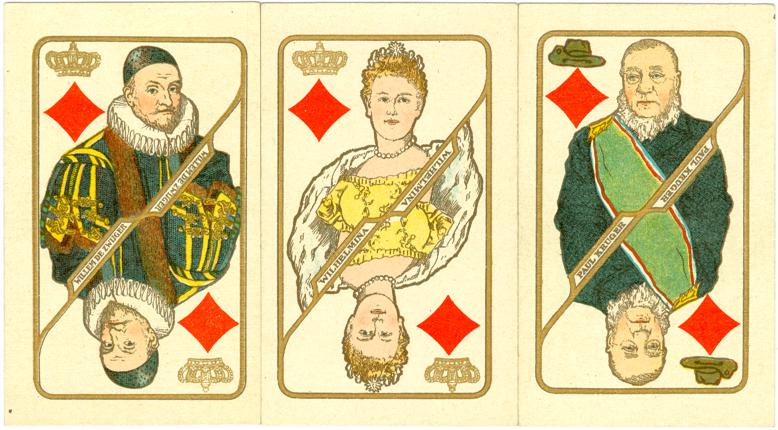
1/ Willem de
Zwijger, "William of Orange, the Silent", was born in 1533 and was
appointed "stadthouder"
(governor) for the provinces of Holland, Zeeland and Utrecht by the King of
Spain in 1559. The northern 7 provinces declared independence in 1581 under
William as Stadthouder. His nickname became "Father of the
Fatherland" and he can be seen as the founder of what later evolved into the
Netherlands. He was assassinated in Delft in 1584.
2/ Queen Wilhelmina, who was born in 1880 and had begun her reign
of the Netherlands in 1898 -only two years before this deck was published- was
nicknamed "Mother of the Fatherland". But we doubt that she
already carried that nickname in 1900 and so it's probably a mere coincidence that they
form a "fitting" couple in this suit.
3/ Paul Kruger (1825-1904) was
State President of the South African Republic (Transvaal) and was the face of
the resistance against the British during the Second Boer War (1899-1902).
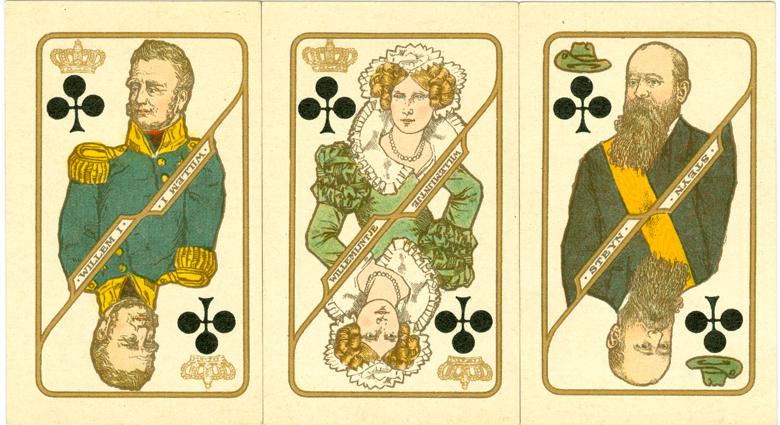
1/ Willem I is
King William I, who reigned from 1813 until 1840, is the first king of the
Netherlands. His ancestors all held the position of Stadhouder, the last being
William V, the father of King William I.
2/ In this suit he's not depicted with
his wife, but with his mother, officially named Frederike Louise Wilhelmine,
Princess of Prusia. In the Netherlands she was known as Princess Wilhelmina. Here she is depicted with her sweet name
Willemijntje.
3/ Steyn was a South African lawyer, politician, and
statesman, sixth and last president of the independent Orange Free State from
1896 to 1902. He was born in 1857 and died in 1916. Under the British occupation
of the Orange Free State Steyn ran his government from the field and played a
key role in continuing the Boer resistance. He also coordinated the guerilla
warfare,
that made up most of the Boer War from 1900 onwards.
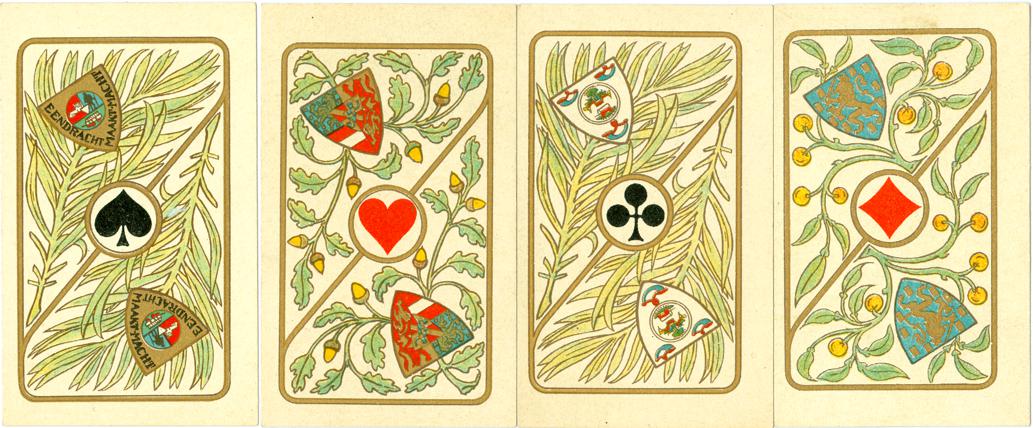
We are no heraldic experts, so we consulted the Dutch "Consulentschap voor de
Heraldiek" and we received the following information from Ir. Anders Daae:
1/
The
Ace of Spades shows the shield of the South African Republic Transvaal with its
motto "Eendracht maakt Macht" (lit. F.G. Brownell, Nasionale en
Provinsiale Simbole).
2/ The Ace of Hearts shows the shield of Prince William I
(lit. T. van der Laars).
3/ The Ace of Clubs shows the shield of the South
African Orange Free State. (lit. F.G. Brownell, Nasionale en Provinsiale
Simbole).
4/ The Ace of Diamonds shows the shield of the Netherlands, as established in 1815
(lit.
T. van der Laars).
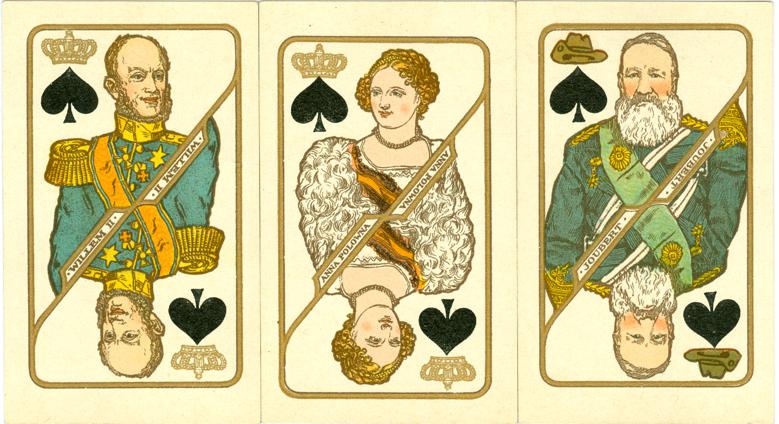
1/ Willem II is King William II,
who was born in 1792 and reigned from 1840 until his death in 1849. Before he
became King of the Netherlands, he was in exile in England after the french had
invaded the Netherlands in 1795. He was aid-de-camp of general Wellesley, the
later Lord Wellington. Willem lead the Dutch and Belgian troops in the battle of
Waterloo in 1815.
2/ Anna Polowna Romanov, a
very wealthy Russian crown-princess, sister of Czar Alexander I, was married to William II from
1816 until his death. They had 5 children, among which was the the later King
William III. After William II died, she came into financial problems and was
forced to sell the paintings that she and William had gathered to her brother.
Nowadays those paintings are still the core of the Dutch collection of the
Hermitage Museum in St. Peterburg.
3/ The Joubert family originally came from
France and first settled in the Cape in 1688. Piet Joubert was born in 1834. He
was successful as a farmer, but also clever in legal affairs and this later
brought him the position of attorney-general. In 1875 he acted as
president during the absence of T.J. Burgers in Europe. From 1880 until his
death in 1900 he was Commandant-General of the South African Republic.
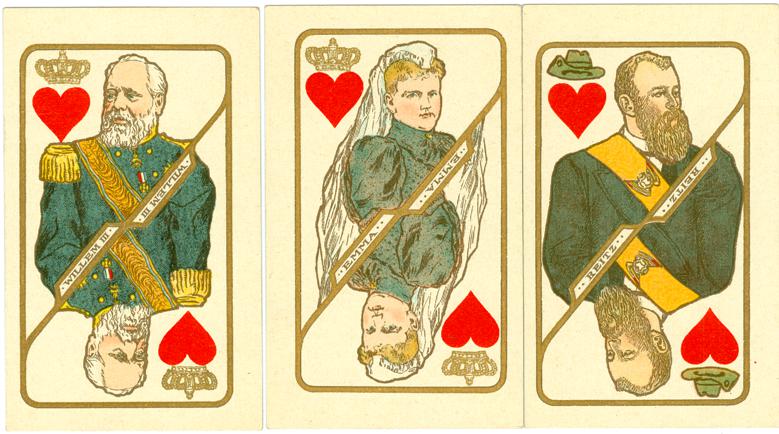
1/ Willem III is
King William III, who was born in 1817 as first son of Willem II and Anna
Polowna. He married his niece Sofia von Württemberg in 1839 and they had 3
sons. But the marriage wasn't a happy one and after the birth of their
third son in 1851, they were living separately until Sofia died in 1877. In
January 1879 he remarries with.....
2/ Emma von Waldeck-Piermont, a German
princess. She was 20 years old at that time. A year later they have a daughter,
Wilhelmina. Because all the sons from his first marriage have died before King
William III's death in 1890, Wilhemina was his successor. But at the age of 10
Wilhelmina couldn't become Queen, so Emma was appointed regentess and she
prepared Wilhelmina for her Queenship.
3/ Deneys Reitz (1882-1944) was
already a Boer commando in his teens. He was 17 years old when he was granted
permission to take part in the second Boer War by Paul Kruger and was issued a a
new Mauser carbine and a bandolier of ammunition by Piet Joubert. He later wrote
a book about the second Boer War, that was edited and published in 1929 as
"Commando: A Boer Journal Of The Boer War".
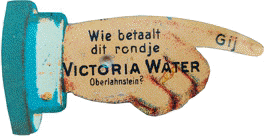
In September 2013
we found an almost mint deck, in the original box. We have replaced the pictures
in this xpo and here below we've added pictures of the box. These show us that
the N.J. Boon firm, which was in charge of distribution, was probably located at
Boompjes 40 in Rotterdam instead of in Amsterdam, where the head office of
Victoria-bron was.
But again...... a BIG THANKS to Lex Rijnen for finding the final
answer for this deck!
(and we also thank Paul Symons for the picture of the advertising
plate)
XPOHOME











